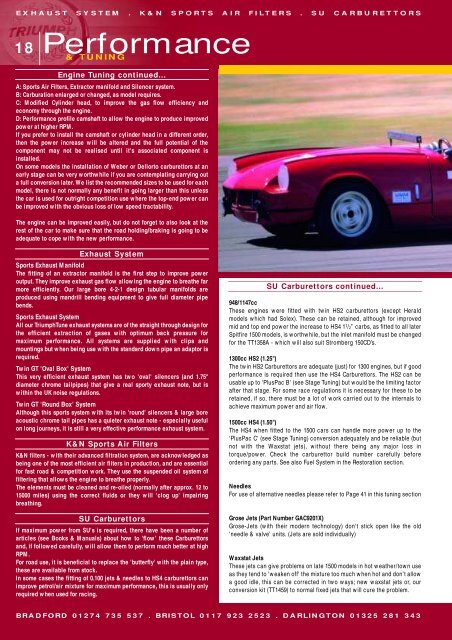You also want an ePaper? Increase the reach of your titles
YUMPU automatically turns print PDFs into web optimized ePapers that Google loves.
EXHAUST SYSTEM . K&N SPORTS AIR FILTERS . SU CARBURETTORS<br />
18<br />
Performance<br />
& TUNING<br />
Engine Tuning continued...<br />
A: Sports Air Filters, Extractor manifold and Silencer system.<br />
B: Carburation enlarged or changed, as model requires.<br />
C: Modified Cylinder head, to improve the gas flow efficiency and<br />
economy through the engine.<br />
D: Performance profile camshaft to allow the engine to produce improved<br />
power at higher RPM.<br />
If you prefer to install the camshaft or cylinder head in a different order,<br />
then the power increase will be altered and the full potential of the<br />
component may not be realised until it's associated component is<br />
installed.<br />
On some models the installation of Weber or Dellorto carburettors at an<br />
early stage can be very worthwhile if you are contemplating carrying out<br />
a full conversion later. We list the recommended sizes to be used for each<br />
model, there is not normally any benefit in going larger than this unless<br />
the car is used for outright competition use where the top-end power can<br />
be improved with the obvious loss of low speed tractability.<br />
The engine can be improved easily, but do not forget to also look at the<br />
rest of the car to make sure that the road holding/braking is going to be<br />
adequate to cope with the new performance.<br />
Exhaust System<br />
Sports Exhaust Manifold<br />
The fitting of an extractor manifold is the first step to improve power<br />
output. They improve exhaust gas flow allowing the engine to breathe far<br />
more efficiently. Our large bore 4-2-1 design tubular manifolds are<br />
produced using mandrill bending equipment to give full diameter pipe<br />
bends.<br />
Sports Exhaust System<br />
All our TriumphTune exhaust systems are of the straight through design for<br />
the efficient extraction of gases with optimum back pressure for<br />
maximum performance. All systems are supplied with clips and<br />
mountings but when being use with the standard down pipe an adaptor is<br />
required.<br />
Twin GT 'Oval Box' System<br />
This very efficient exhaust system has two 'oval' silencers (and 1.75"<br />
diameter chrome tailpipes) that give a real sporty exhaust note, but is<br />
within the UK noise regulations.<br />
Twin GT 'Round Box' System<br />
Although this sports system with its twin 'round' silencers & large bore<br />
acoustic chrome tail pipes has a quieter exhaust note - especially useful<br />
on long journeys, it is still a very effective performance exhaust system.<br />
K&N Sports Air Filters<br />
K&N filters - with their advanced filtration system, are acknowledged as<br />
being one of the most efficient air filters in production, and are essential<br />
for fast road & competition work. They use the suspended oil system of<br />
filtering that allows the engine to breathe properly.<br />
The elements must be cleaned and re-oiled (normally after approx. 12 to<br />
<strong>1500</strong>0 miles) using the correct fluids or they will 'clog up' impairing<br />
breathing.<br />
SU Carburettors<br />
If maximum power from SU's is required, there have been a number of<br />
articles (see Books & Manuals) about how to 'flow' these Carburettors<br />
and, if followed carefully, will allow them to perform much better at high<br />
RPM.<br />
For road use, it is beneficial to replace the 'butterfly' with the plain type,<br />
these are available from stock.<br />
In some cases the fitting of 0.100 jets & needles to HS4 carburettors can<br />
improve petrol/air mixture for maximum performance, this is usually only<br />
required when used for racing.<br />
SU Carburettors continued...<br />
948/1147cc<br />
These engines were fitted with twin HS2 carburettors (except Herald<br />
models which had Solex). These can be retained, although for improved<br />
mid and top end power the increase to HS4 1 1/2” carbs, as fitted to all later<br />
Spitfire <strong>1500</strong> models, is worthwhile, but the inlet manifold must be changed<br />
for the TT1358A - which will also suit Stromberg 150CD’s.<br />
1300cc HS2 (1.25")<br />
The twin HS2 Carburettors are adequate (just) for 1300 engines, but if good<br />
performance is required then use the HS4 Carburettors. The HS2 can be<br />
usable up to 'PlusPac B' (see Stage Tuning) but would be the limiting factor<br />
after that stage. For some race regulations it is necessary for these to be<br />
retained, if so, there must be a lot of work carried out to the internals to<br />
achieve maximum power and air flow.<br />
<strong>1500</strong>cc HS4 (1.50")<br />
The HS4 when fitted to the <strong>1500</strong> cars can handle more power up to the<br />
'PlusPac C' (see Stage Tuning) conversion adequately and be reliable (but<br />
not with the Waxstat jets), without there being any major loss in<br />
torque/power. Check the carburettor build number carefully before<br />
ordering any parts. See also Fuel System in the Restoration section.<br />
Needles<br />
For use of alternative needles please refer to Page 41 in this tuning section<br />
Grose Jets (Part Number GAC9201X)<br />
Grose-Jets (with their modern technology) don't stick open like the old<br />
'needle & valve' units. (Jets are sold individually)<br />
Waxstat Jets<br />
These jets can give problems on late <strong>1500</strong> models in hot weather/town use<br />
as they tend to 'weaken off' the mixture too much when hot and don't allow<br />
a good idle, this can be corrected in two ways; new waxstat jets or, our<br />
conversion kit (TT1459) to normal fixed jets that will cure the problem.<br />
BRADFORD 01274 735 537 . BRISTOL 0117 923 2523 . DARLINGTON 01325 281 343


